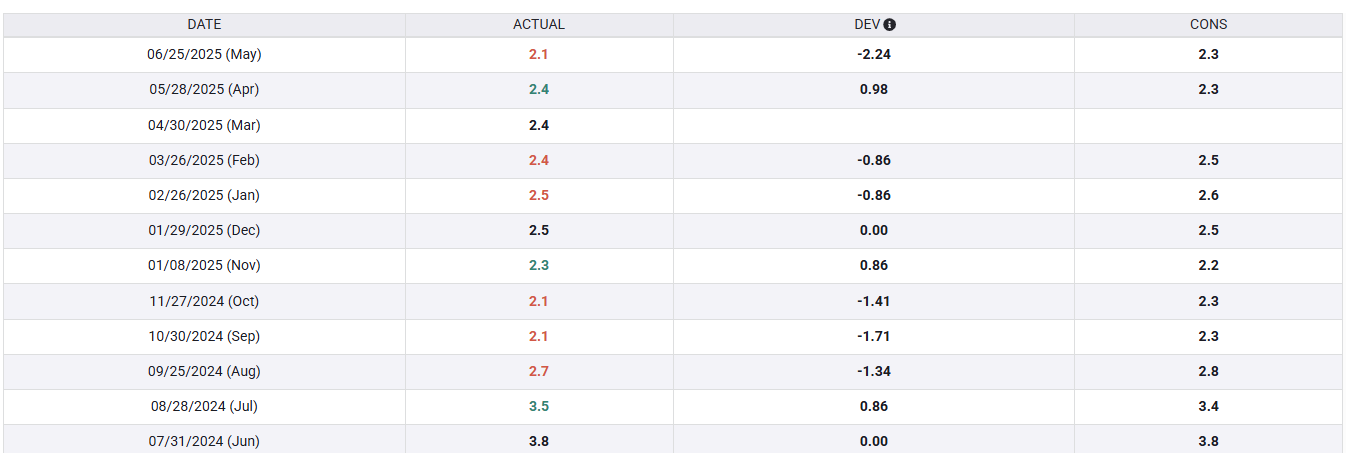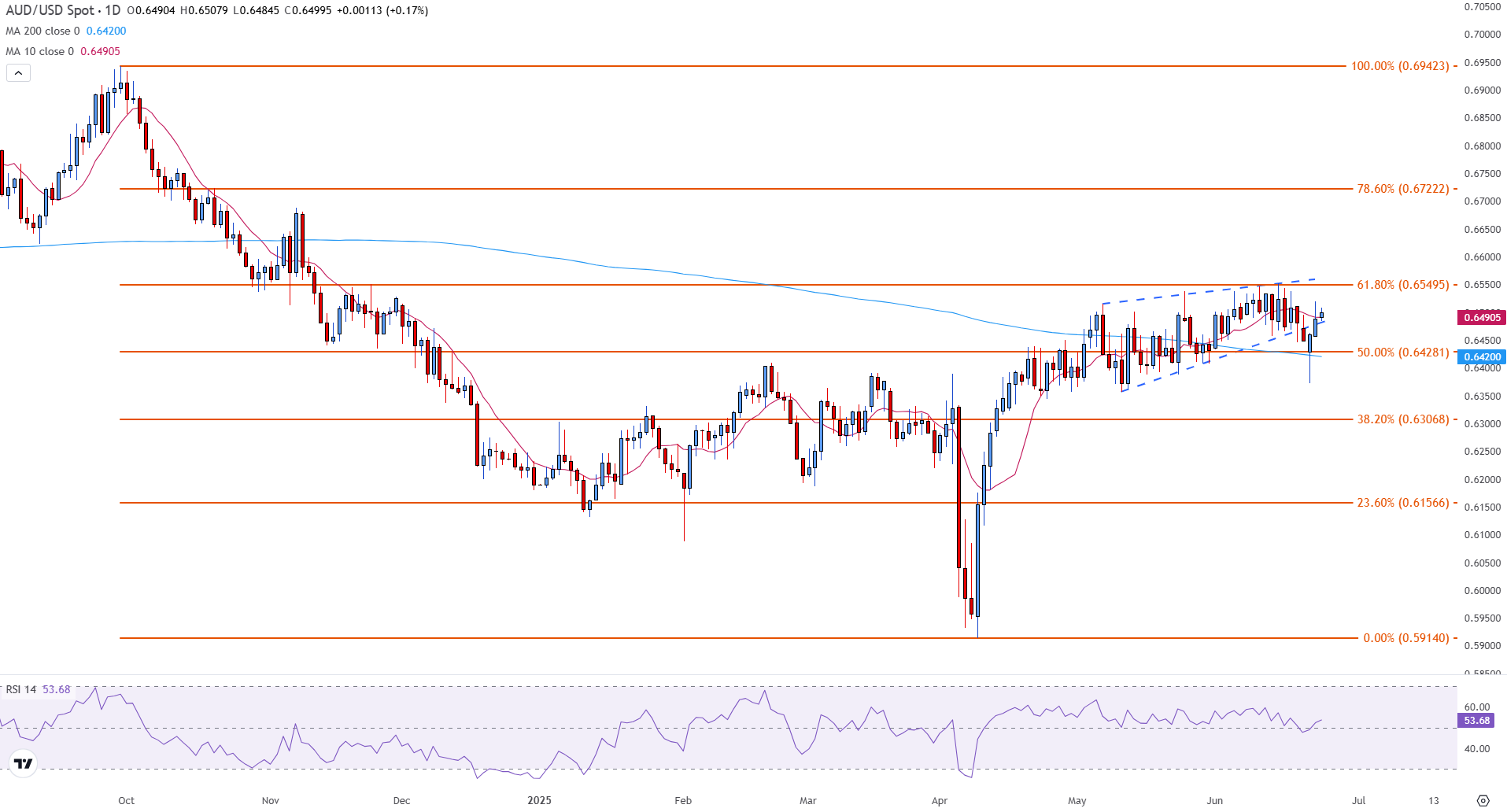AUD/USD steadies as markets assess central bank policy and growth prospects
- Fed Powell’s hawkish tone limits US Dollar losses as markets continue to price in a September rate cut, providing temporary support for US Treasury yields.
- Australian inflation softens, raising expectations of an RBA rate cut in July.
- AUD/USD hovers around 0.6500 as traders await the next fundamental drivers.
The Australian Dollar (AUD) is steadying against the US Dollar (USD), following a two-day rally that lifted AUD/USD back above 0.6500.
With risk-on sentiment returning to markets following Tuesday’s confirmation of a ceasefire between Israel and Iran, the Australian Dollar has benefited from easing geopolitical tensions.
However, with prices now recovering above the 200-day Simple Moving Average (SMA), bullish momentum may be beginning to lose steam. As technical and fundamental factors contribute to driving price action, the relative performance of the two economies and interest rate expectations have returned to focus.
Australia’s Monthly Consumer Price Index (CPI) data, released on Wednesday, revealed that price pressures continued to ease.
While analysts had anticipated the annual inflation rate to rise by 2.3% in May, the actual figure printed at 2.1%.

Australian monthly inflation data table for the period July 2024 - May 2025 - Source FXStreet
The softer inflation print raised expectations that the Reserve Bank of Australia (RBA) would announce another rate cut in July.
Attention then shifted back to the United States, where markets awaited more comments from Federal Reserve (Fed) Chair Jerome Powell.
As Powell testified before the US Senate Committee on Banking, Housing and Urban Affairs, he continued to express optimism about the US economy. His comments, from Tuesday and Wednesday, have done little to change the projected trajectory for interest rates, at least not for now. This leaves expectations for a Fed rate cut priced in for September, which has offered some support to the US Dollar and Treasury yields.
Although diverging monetary policy should be lifting the US Dollar, the current economic uncertainty and weaker economic data are limiting its gains.
AUD/USD hovers around 0.6500, with prices remaining within the confines of a rising wedge
From a technical standpoint, AUD/USD continues to trade within the confines of a rising wedge formation on the daily chart.
Prices are currently testing an important zone of technical confluency around the key psychological level of 0.6500. Support is forming at the 10-day Simple Moving Average (SMA) at 0.6490, which aligns with the lower boundary of the rising wedge pattern.

A clear break of the 0.6500 level could see bulls aiming for a retest of the 61.80% Fibonacci retracement level of the September-April decline near 0.6550.
However, if bearish momentum builds, a move below the rising trendline support could see a deeper pullback to the mid-point of the above-mentioned move at 0.6428.
Australian Dollar FAQs
One of the most significant factors for the Australian Dollar (AUD) is the level of interest rates set by the Reserve Bank of Australia (RBA). Because Australia is a resource-rich country another key driver is the price of its biggest export, Iron Ore. The health of the Chinese economy, its largest trading partner, is a factor, as well as inflation in Australia, its growth rate and Trade Balance. Market sentiment – whether investors are taking on more risky assets (risk-on) or seeking safe-havens (risk-off) – is also a factor, with risk-on positive for AUD.
The Reserve Bank of Australia (RBA) influences the Australian Dollar (AUD) by setting the level of interest rates that Australian banks can lend to each other. This influences the level of interest rates in the economy as a whole. The main goal of the RBA is to maintain a stable inflation rate of 2-3% by adjusting interest rates up or down. Relatively high interest rates compared to other major central banks support the AUD, and the opposite for relatively low. The RBA can also use quantitative easing and tightening to influence credit conditions, with the former AUD-negative and the latter AUD-positive.
China is Australia’s largest trading partner so the health of the Chinese economy is a major influence on the value of the Australian Dollar (AUD). When the Chinese economy is doing well it purchases more raw materials, goods and services from Australia, lifting demand for the AUD, and pushing up its value. The opposite is the case when the Chinese economy is not growing as fast as expected. Positive or negative surprises in Chinese growth data, therefore, often have a direct impact on the Australian Dollar and its pairs.
Iron Ore is Australia’s largest export, accounting for $118 billion a year according to data from 2021, with China as its primary destination. The price of Iron Ore, therefore, can be a driver of the Australian Dollar. Generally, if the price of Iron Ore rises, AUD also goes up, as aggregate demand for the currency increases. The opposite is the case if the price of Iron Ore falls. Higher Iron Ore prices also tend to result in a greater likelihood of a positive Trade Balance for Australia, which is also positive of the AUD.
The Trade Balance, which is the difference between what a country earns from its exports versus what it pays for its imports, is another factor that can influence the value of the Australian Dollar. If Australia produces highly sought after exports, then its currency will gain in value purely from the surplus demand created from foreign buyers seeking to purchase its exports versus what it spends to purchase imports. Therefore, a positive net Trade Balance strengthens the AUD, with the opposite effect if the Trade Balance is negative.

